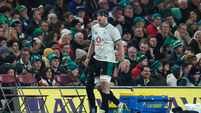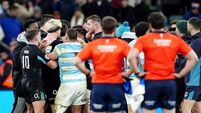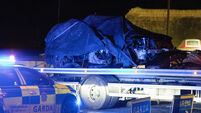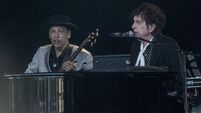The start of something special
The respective captains that day, Reggie Corrigan and Mick Galwey, met this week at the CityWest Hotel with Diarmuid O’Flynn to discuss the early stages of the current rivalry
“The first time I played against you – and you probably don’t even remember it – was when I was with Greystones, an AIL game against Shannon down in Thomond Park. We beat ye, 700 supporters travelled down by train.”
“Don’t tell me you’re still talking about that! That was 1992, and ye beat us again the following year, 93, up in Greystones, but we won four-in-a-row afterwards and there’s no word about that.”
“Give us a break – we didn’t win very much but that was a big one, we had a good year that year. We had Spud (Johnny Murphy, out-half), Brian Rigney, Poppy, Des Rigney, who hurled for Laois, and we had good backs as well.”
“When people – Munster people especially – think about Leinster rugby, they don’t think about teams like that, do they?”
“No they don’t, they’re not really counted. The AIL was great in those years, before professionalism, and that was a very good year for us. You had all your internationals playing with the clubs then, so it meant something, those were big games.”
“Was it really amateur then though – there were rumours of big payments being made to the better players?”
“Ye were getting the brown envelopes, that’s what I heard.”
“Don’t mind your brown envelope – brown paper bag! But it was huge – you could say that Ireland’s success afterwards was built on Munster, and Munster’s success was built on Shannon. If you look at the Munster team even today – Marcus Horan, Alan Quinlan, John Hayes, Jerry Flannery, Anthony Foley – all of those were blooded in the senior game with Shannon in the AIL. That’s one area where I’d worry today, that’s not really happening anymore.”
“They’re leaving school and going straight into the professional setup at provincial level, or into the Academy; even when they do play AIL, they’re not getting the same level of competition as was there in the beginning.”
“The Academy is fine, it makes them physically stronger, shows them the way to go with diet and preparation and all that, but it doesn’t give you the mental toughness that you developed from playing in the AIL.”
“A 3-3 draw against Young Munster down in Greenfields – that was some experience!”
“A bloodbath in a mud-bath! You could have hammered them out the gate the week before, annihilated them 6-0 – which would be the equivalent of 50-0 today, especially against them! – owned the ball, but when they got you down there…”
“And of course there was Claw (Peter Clohessy, another legendary prop, with Young Munster) – himself and Poppy had an agreement between themselves, just lie in to the scrum, no pushing!”
“Brilliant! Were you in the front row that time?”
“No, I played second-row for Greystones for four or five years, then I got stuck in to loose head.”
“That’s what happened to John Hayes as well; he was second-row for us, wasn’t playing rugby long, we sent him to New Zealand and he came back a monster! I don’t know what he was doing out there but he was now an absolute monster. He said he’d been tried at prop, and we were interested in this. He was struggling a bit in the beginning so we put him back in the second row – it didn’t last long; Buddha (Noel Healy, and yes, yet another legendary prop) was trying to lift him in the lineout one day and he broke his finger. After that he was told – “Hayes, back to the front row, because none of us are going to lift you!”
“What was the Munster/Leinster rivalry like at that stage, just the interpros then?”
“I don’t really know, I didn’t start playing for Leinster until 1997. I was on a part-time contract, £7,500 a year. I used to work for United Drugs, spent a year with them in purchasing, then went to a Freight company in Sales – an alright job, but not a great job. I was called in for a Leinster trial, two stone overweight – but they offered me a part-time contract. After about two months of that I knew I couldn’t keep going – it was a part-time contract but full-time training, so I made the choice, took a chance, gave up the job. Fortunately that year I played for Leinster, which put me up another level again on the contract scale – that was the start of it, I was soon on a million a year!”
“I was playing with Munster for a good few years before it all turned professional. 1987 was my first cap. I played 17 seasons, quite a long time. Myself and Claw actually started with Munster the same year. I was still playing football at the time, wasn’t playing rugby very long. Only three interpro games a season then, home and away every second year, but sometimes you met a touring side. I remember in 1988, we played London Counties, who would have been made up of Wasps, Saracens, Harlequins – all the big London teams – and I remember going out the gate afterwards, meeting (Irish selector) Jerry Murray: “We’ve been watching you for a while, there’s an Irish squad session tomorrow in Dublin, you might come up and join us.” St Kieran’s were playing in the Kerry county final next day, my own division. “I can’t, I have a county final, I’ll be lynched at home if I miss that!”
“That’s fine,” he said, “But how am I going to explain it to Jimmy Davidson!” I still got my break anyway, the French Barbarians, down in the a**ehole of France; they were well named – the forwards were filthy and the backs were worse.”
When did you first start to come up against Leinster?
“It was Thomond Park, 1987; Wardy was with Leinster, he was the glamour boy, was now back at Thomond Park, which was a big thing – Tucker just ran straight at him all day. Colm was a mountain of a man at the time, Niall O’Donovan was there, Willie Sexton, Donal Lenihan, Terry Kingston, Paco, Claw – there was a good pack there.”
“Then came the 2001 (Celtic League) final and things started to change. I remember the build-up that week, they had the two of us in for a photo shoot at Lansdowne – they had lights coming up from the trophy and all that kind of stuff, a lot of hype. That sort of kick-started the whole rivalry thing, it put over 30,000 people into Lansdowne Road, which was unheard of at the time. The supporters were fairly evenly matched as well – in fact there might even have been slightly more blue.”
Was there much talk among the players after the 2001 final?
“There was a dinner down in the Pavilion afterwards but Munster had to head away early – they were full sure they were going to win so they had a party arranged for themselves down in Limerick.”
“Don’t mind that sh**e! We had a party organised alright, but it was for the Monday night! The boys were all gone, there I was downstairs (in Lansdowne), the only one left – I remember at one stage they were giving Mattie Williams the high chair, and I slipped away. Of course I was back in Munster the following week and telling them, “Right lads, this is what went on after ye left…”
“When we went down to 14 it was hard to turn around the lads and convince them, we could still do this. Then Spooner made a great break in the second half for Horgan’s try, and we pushed on from there. In some ways, you know the way they say that when you’re down a man it can galvanise a team, and that’s what happened with us. If it had stayed at 15 on 15, who knows how it might have ended?”
“Was that the major turning point for Munster, Mick?”
“It was. We’d lost the Heineken Cup final of 2000, lost that one in 2001, November was it?”
“December, the 15th, 24-20…”
“Christ, he even remembers the date and score! No-one ever talks about the final two years later, when we won – it’s like that final never happened. But we had reached the Heineken Cup final of 2000, and I’d say it’s fair to say that ye were playing second fiddle to us at the time. Then we get to that league final and ye opened our holes – that turned things for us.”
“That was when the whole Red Army thing really started to build, after that.”
“A lot of that army came from other parts of Ireland, from rural Leinster especially.”
“Carlow, Laois, Kilkenny, places like that – the Lunsters, I call them, Lunstermen. It’s something I can’t stand, the fact that they turn their backs on their own province to support another province – it drives me mad. I’ve had many conversations with them about it, and what they’ll say is, they like the brand of rugby Munster play, they like the craic. They can’t relate to the Dublin 4 attitude, but there isn’t a single player on this team from D4. A lot of this is press-fabricated anyway – yes there are knob-jockeys, of course there are, but just as every fella who supports Munster hasn’t crawled out of a bog with a pint of Murphys in his fist…”
“Murphys? That’s the Cork crowd!”
“A lot of those I met said it was also about the fact that Munster never let them down, always gave 100 percent, while Leinster could be brilliant one day, very poor the next.”
“For the last four or five years Munster have been just an amazing team, but you could argue, going back to the years we were just talking about, that Munster didn’t deliver either, that there were games when they didn’t play brilliantly, like in that 2001 final, a game they should have won, and the 2000 Heineken Cup final. The difference is that the team they have at the moment is phenomenal. I mean, regardless of how you look at it, they’re an amazing rugby team.”
“It’s still a derby game on Saturday. You take any sport; if you have two fierce local rivals, it’s very hard for one to put it over the other three times in the one season – that’s a big ask. Leinster are waiting in the long grass.”














